Steve Jobs facts for kids
Quick facts for kids
Steve Jobs
|
|
|---|---|
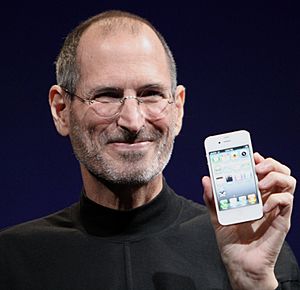
Jobs introducing the iPhone 4, 2010
|
|
| Born |
Steven Paul Jobs
February 24, 1955 San Francisco, California, U.S.
|
| Died | October 5, 2011 (aged 56) Palo Alto, California, U.S.
|
| Resting place | Alta Mesa Memorial Park |
| Education | Reed College (no degree) |
| Years active | 1971–2011 |
| Known for |
|
| Title |
|
| Board member of |
|
| Spouse(s) | |
| Partner(s) | Chrisann Brennan (1972–1977) |
| Children | 4, including Lisa, Reed, and Eve |
| Relatives |
|
| Awards | Presidential Medal of Freedom (posthumous, 2022) |
| Signature | |
Steven Paul Jobs (February 24, 1955 – October 5, 2011) was an American business magnate and inventor. He was best known as the co-founder, chairman, and CEO of Apple. He also led Pixar, the animation studio, and founded NeXT, another computer company.
Steve Jobs is seen as a key figure in the personal computer revolution. He worked with his friend and fellow Apple co-founder, Steve Wozniak, to make computers popular for everyone.
Contents
- Early Life and Education
- Building Apple: A Computer Revolution
- NeXT: A New Computer Company
- Pixar: Animated Movie Magic
- Returning to Apple: A New Era
- Personal Life
- Health Challenges and Passing
- Innovations and Designs
- Giving Back: Philanthropy
- Awards and Recognition
- Steve Jobs's Famous Quotes
- Interesting Facts About Steve Jobs
- Images for kids
- See also
Early Life and Education
Steven Paul Jobs was born in San Francisco, California, U.S., on February 24, 1955. His birth parents were Joanne Schieble and Abdulfattah "John" Jandali. They wanted him to be adopted by college graduates. However, he was adopted by Paul and Clara Jobs, who promised he would go to college.
Paul and Clara also adopted Steve's sister, Patricia, in 1957. By 1959, the family moved to Mountain View, California. Steve's father, Paul, built a workbench in their garage. He wanted to share his love for mechanics with his son. Steve admired his father's skill, saying he "knew how to build anything."
By age ten, Steve was very interested in electronics. He became friends with many engineers in his neighborhood. He went to Monta Loma Elementary School. Steve often played pranks at school, but his father never got mad. Instead, he thought the school wasn't challenging his smart son enough.
In 1972, Jobs attended Reed College. He left college that same year.
Building Apple: A Computer Revolution

Steve Jobs was a businessman in Silicon Valley. He became famous for his work with Apple Computer Inc. This began with the release of the Apple I in 1976.
Jobs and Steve Wozniak helped make personal computers popular in the late 1970s. In the early 1980s, Jobs was one of the first to see how useful a mouse could be. It allowed people to control things on a computer screen easily.
A year later, the Apple II brought them fame and wealth. It was one of the first very successful mass-produced microcomputers. Jobs also saw the potential of the Xerox Alto computer in 1979. This computer used a mouse and a graphical user interface (GUI). This led to the creation of the Apple Lisa in 1983.
The Macintosh followed in 1984. It was the first mass-produced computer with a GUI. The Macintosh also helped start the desktop publishing industry in 1985. This happened with the Apple LaserWriter, a laser printer that used vector graphics.
In 1985, Jobs left Apple after disagreements with the company's board and CEO, John Sculley.
NeXT: A New Computer Company
After leaving Apple, Jobs started a new company called NeXT. He took some Apple employees with him. NeXT focused on making computers for colleges and businesses.
Pixar: Animated Movie Magic
Jobs also helped the visual effects industry grow. In 1986, he invested in the computer graphics part of George Lucas's company, Lucasfilm. This new company became Pixar.
Pixar made many successful films, like Toy Story (1995), Monsters, Inc. (2001), and Cars (2006). In 2006, Jobs sold Pixar to Disney. He then joined Disney's board of directors. Jobs made more money from Pixar than he did from Apple in the 1970s and 80s.
Returning to Apple: A New Era
In 1997, Jobs came back to Apple as CEO. This happened after Apple bought NeXT. He was key in saving Apple, which was close to going bankrupt.
He worked closely with designer Jony Ive. Together, they created many popular products. These included the Apple Store, App Store (iOS), iMac, iPad, iPod, and iPhone. They also launched the "Think different" advertising campaign.
In 2001, the original Mac OS was replaced with Mac OS X (now called macOS). This new system was based on NeXT's NeXTSTEP platform. It gave Apple's operating system a modern, Unix-based foundation.
Personal Life
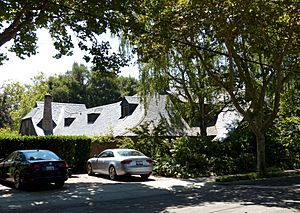
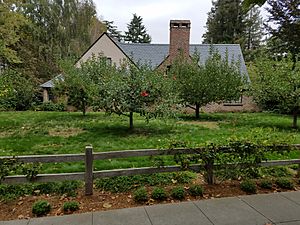
Steve Jobs had a daughter named Lisa with his girlfriend, Chrisann Brennan. Lisa was born on May 17, 1978. For some years, Jobs did not admit he was her father, but he later did.
In 1989, Jobs met his future wife, Laurene Powell. They met when he gave a lecture at Stanford Graduate School of Business. They married on March 18, 1991. Their first child, a son named Reed, was born in 1991. They also had two daughters, Erin (born 1995) and Eve Jobs (born 1998), who is a fashion model. The family lived in Palo Alto, California.
When Jobs met his biological mother, he found out he had a sister, Mona Simpson. They became very close. Jobs never met his biological father.
Health Challenges and Passing
In 2003, Jobs was diagnosed with a rare form of pancreatic neuroendocrine tumor. In 2009, he had a liver transplant. His doctors said his outlook was "excellent."
Steve Jobs passed away on October 5, 2011, at age 56. He died from problems related to the tumor. Tim Cook became the new CEO of Apple after his death.
Many famous people shared their thoughts after his death. These included Steve Wozniak, George Lucas, Bill Gates, and President Barack Obama. At his request, Jobs was buried in an unmarked grave in Alta Mesa Memorial Park.
Innovations and Designs
Steve Jobs was known for his focus on design. His ideas were influenced by Zen and Buddhism. He is listed as an inventor or co-inventor on hundreds of patents. These patents cover everything from computers and phones to user interfaces and even staircases.
Apple I
Steve Wozniak designed the Apple I. But Jobs had the idea to sell it as a desktop computer. This led to the start of Apple Computer in 1976. Jobs and Wozniak built some of the first Apple I computers by hand. They sold some of their belongings to fund this. Eventually, 200 units were made.
Apple II
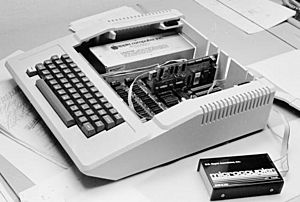
The Apple II was an 8-bit home computer. It was one of the first very successful mass-produced microcomputers. Wozniak designed most of it. Jobs oversaw the design of its unique case. It was launched in 1977 as Apple's first consumer product.
Apple Lisa
The Lisa was a personal computer developed by Apple. It was sold in the early 1980s. It was the first personal computer with a graphical user interface for business users. The Lisa did not sell very well.
In 1982, Jobs took over the Macintosh project. He added ideas from the Lisa to it.
Macintosh
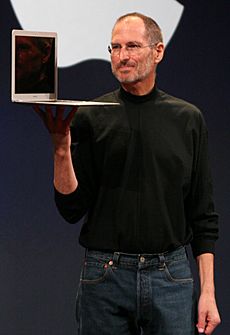
The Macintosh was launched on January 24, 1984. It was the first mass-market personal computer with a graphical user interface and a mouse. This first model was later called the Macintosh 128k. Since 1998, Apple has used "Mac" instead of "Macintosh."
The Macintosh was introduced with a famous TV commercial called "1984." It aired during the Super Bowl. The ad showed the Macintosh as a way to save people from a world controlled by a "Big Brother" figure.
The Macintosh was expensive, which made it hard to compete with cheaper computers. But it was very successful in education and desktop publishing. It helped Apple stay a top PC maker for many years.
NeXT Computer
After leaving Apple in 1985, Jobs started NeXT. The NeXT Computer was introduced in 1988. Tim Berners-Lee used a NeXT Computer to create the world's first web browser, the WorldWideWeb. The NeXT Computer's operating system, NeXTSTEP, became the base for Apple's macOS and iOS.
iMac
The iMac G3 was introduced in 1998. Its new design was a direct result of Jobs returning to Apple. Apple said, "the back of our computer looks better than the front of anyone else's." The first iMac was bright blue and looked very different from other computers.
The iMac also made important changes, like removing the floppy disk drive. It used only USB for connecting other devices. This helped make USB popular for many other products.
iTunes
iTunes is a program from Apple used to play, download, and organize music and videos. It also manages mobile devices. The iTunes Store lets users buy and download music, movies, and TV shows. You can also get apps for iPhone, iPad, and iPod Touch from the App Store.
iPod
The first iPod was released on October 23, 2001. Its main new feature was its small size. It used a small hard drive, unlike other players at the time. The first iPod could hold 5 GB to 10 GB of music. It sold for US$399. Over 100,000 iPods were sold by the end of 2001. The iPod's success made Apple a big player in the music industry. It also paved the way for the iTunes music store and the iPhone.
iPhone
Apple started working on the first iPhone in 2005. It was released on June 29, 2007. The iPhone was a huge hit. Time magazine called it "Invention of the Year" for 2007. The iPhone had multimedia features and was a touch screen smartphone.
Later versions, like the iPhone 3G and iPhone 3GS, added features like GPS and a better camera. The iPhone 4 was thinner and had a five-megapixel camera. The iPhone 4S introduced Siri, a virtual assistant that could understand voice commands.
iPad
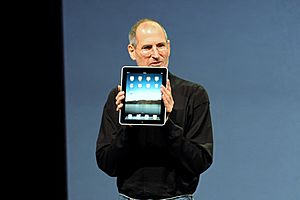
The iPad is a line of tablet computers from Apple. The first iPad was released on April 3, 2010. Its user interface uses a multi-touch screen and a virtual keyboard. iPads have built-in Wi-Fi and some models also have cellular connectivity. By April 2015, over 250 million iPads had been sold.
Giving Back: Philanthropy
After leaving Apple the first time, Steve Jobs started a charity called the Steven P. Jobs Foundation. However, it closed without much activity. He chose not to sign The Giving Pledge, which encourages billionaires to donate most of their wealth.
Jobs did donate $50 million to Stanford hospital. He also helped efforts to cure AIDS. Bono said that Apple, under Jobs, gave "tens of millions of dollars" to AIDS and HIV programs in Africa. This inspired other companies to donate too.
Awards and Recognition

- 1985: National Medal of Technology (with Steve Wozniak) from US President Ronald Reagan.
- 1987: Jefferson Award for Public Service.
- 1989: Named Entrepreneur of the Decade by Inc. magazine.
- 2004–2010: Listed among the Time 100 Most Influential People in the World five times.
- 2007: Named the most powerful person in business by Fortune magazine.
- 2007: Inducted into the California Hall of Fame.
- 2012: Received a Grammy Trustees Award for his influence on the music industry.
- 2012: Posthumously honored with an Edison Achievement Award for his innovation.
- 2013: Posthumously inducted as a Disney Legend.
- 2017: The Steve Jobs Theater opened at Apple Park.
- 2022: Posthumously awarded the Presidential Medal of Freedom by US President Joe Biden. This is the country's highest civilian honor.
Steve Jobs's Famous Quotes
- "Of all the inventions of humans, the computer is going to rank near or at the top as history unfolds and we look back. It is the most awesome tool that we have ever invented."
- "I always thought of myself as a humanities person as a kid, but I liked electronics… then I read something that one of my heroes, Edwin Land of Polaroid, said about the importance of people who could stand at the intersection of humanities and sciences, and I decided that's what I wanted to do."
- "My favorite things in life don't cost any money. It's really clear that the most precious resource we all have is time."
- "Great things in business are never done by one person. They're done by a team of people."
- "Sometimes life hits you in the head with a brick. Don't lose faith."
- "Technology is nothing. What's important is that you have a faith in people, that they're basically good and smart, and if you give them tools, they'll do wonderful things with them."
Interesting Facts About Steve Jobs
- As a child, Jobs found it hard to make friends and was often seen as a "loner."
- He took ballet classes when he was young.
- Jobs struggled in traditional classrooms and often misbehaved. He was suspended a few times.
- He gave credit to his fourth-grade teacher for making him love learning.
- Jobs skipped the 5th grade and went straight to 6th grade.
- He was often bullied in middle school. In 7th grade, he told his parents they had to take him out of that school or he would quit.
- When he was 13, in 1968, Bill Hewlett (from Hewlett-Packard) gave Jobs a summer job. Jobs had called him to ask for parts for an electronics project.
- Jobs dropped out of college after only a few months.
- He studied Zen Buddhism in India. He kept his appreciation for Zen throughout his life.
- The house where Steve Jobs grew up in Los Altos, California, was declared a historic site in 2013. It was the first location of Apple Computer.
- Jobs usually wore a black long-sleeved mock turtleneck, Levi's 501 blue jeans, and New Balance 991 sneakers.
- Even though he was a billionaire, Jobs said that most of his money would not go to his children. He also limited his children's access to social media, computer games, and the Internet.
- Jobs has been played by actors Ashton Kutcher in the 2013 movie Jobs and Michael Fassbender in the 2015 movie Steve Jobs.
Images for kids
-
A prototype of the original Macintosh from c. 1981 (at the Computer History Museum)
-
Jobs demonstrating the iPhone 4 to Russian President Dmitry Medvedev on June 23, 2010
-
Flags flying at half-staff outside Apple HQ in Cupertino, on the evening of Jobs's death
-
Jobs unveiling the iPhone at MacWorld Conference & Expo on January 9, 2007
- Bill Gates, founder of Microsoft
- Mark Zuckerberg, founder of Facebook
- Jeff Bezos, founder of Amazon
See also
 In Spanish: Steve Jobs para niños
In Spanish: Steve Jobs para niños








